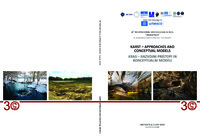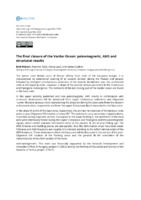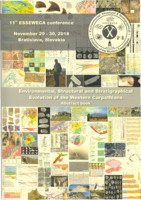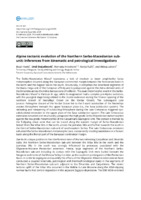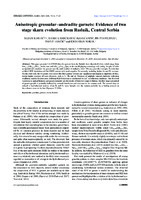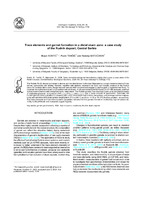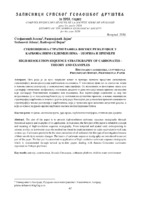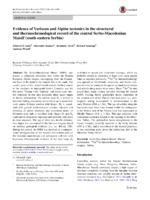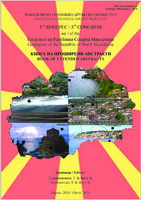Претрага
174 items
-
Stratigraphy and Microfauna (Radiolarians and Foraminifera) of the Upper Cretaceous (Upper Santonian–Lower Campanian) Carbonate Deposits in the Area of Struganik Village, Western Serbia)
Santonian, Campanian, radiolarians, planktonic foraminifera, biostratigraphy, limestones, Struganik, SerbiaLiubov Bragina, Nikita Bragin, Luidmila Kopaevich, Nevenka Đerić, Nataša Gerzina Spajić. "Stratigraphy and Microfauna (Radiolarians and Foraminifera) of the Upper Cretaceous (Upper Santonian–Lower Campanian) Carbonate Deposits in the Area of Struganik Village, Western Serbia)" in Stratigraphy and Geological Correlation, Pleiades Publishing Ltd (2020). https://doi.org/10.1134/S0869593820010037
-
Strain partitioning in a large intracontinental strike-slip system accommodating backarc-convex orocline formation: The Circum-Moesian Fault System of the Carpatho-Balkanides
Nemanja Krstekanić, Liviu Matenco, Uroš Stojadinović, Ernst Willingshofer, Marinko Toljić, Daan Tamminga (2022)oroklini, raspodela deformacija, transkurentna kretanja, Karpato-balkanidi, Cirkum-mezijski rasedni sistem... therein). The Carpatho-Balkanides orogen (Fig. 1a) formed during the Cretaceous – Miocene closure of the Alpine Tethys Ocean (Csontos and Vörös, 2004; Horváth et al., 2015; Maţenco, 2017). The initial late Early Cretaceous partial closure of the Ceahlău–Severin branch in the South and Serbian ...
... anticline (Fig. 2), Tithonian – Lower Cretaceous clastic to calcareous turbidites overlie the Danubian units and are thrusted by the Getic nappe of the Dacia-mega unit (Anđelković et al., 1977; Petrović et al., 1973; Vujisić et al., 1980). The late Early Cretaceous (~100–110 Ma) thrusting of the Supra- ...
... clastics and Middle to Upper Triassic carbonates, a Lower to Middle Jurassic clastic succession, Middle Jurassic to late Early Cretaceous carbonates and locally Late Cretaceous fine-grained sediments (Fig. 3, Anđelković et al., 1977; Bogdanović and Rakić, 1980; Iancu et al., 2005a; Kalenić et ...Nemanja Krstekanić, Liviu Matenco, Uroš Stojadinović, Ernst Willingshofer, Marinko Toljić, Daan Tamminga. "Strain partitioning in a large intracontinental strike-slip system accommodating backarc-convex orocline formation: The Circum-Moesian Fault System of the Carpatho-Balkanides" in Global and Planetary Change, Elsevier BV (2022). https://doi.org/10.1016/j.gloplacha.2021.103714
-
Clockwise rotation in the Serbian segment of the Vardar zone and in the Danubicum of Eastern Serbia - tetonic implication
Vesna Lesić, Emo Marton, Vesna Cvetkov, Dragana Tomić. "Clockwise rotation in the Serbian segment of the Vardar zone and in the Danubicum of Eastern Serbia - tetonic implication" in 5. Hrvatski geološki kongres. Abstract Book 5th Croatian Geological Congress, Hrvatski geološki institut (2015)
-
To what extent reactivated faults are (not) responsible for karst process: example from Serbian Carpatho-Balkanides?
Ana Mladenović, Jelena Ćalić (2023)Carpatho-Balkanides represent part of the complex Dinaric – Carpatho – Balkan orogenic system, that geomorphologically dominates the central part of the Balkan Peninsula. The existence of this orogenic system is a result of closure of the Neotethys ocean and subsequent convergence of the Adriatic microplate and the Eurasian continent, that has been still active in the recent times. Such geodynamic characteristics conditioned complex tectonic structures, multiply reactivated during Late Cretaceous and Cenozoic times. The main aim of this work ...Ana Mladenović, Jelena Ćalić. "To what extent reactivated faults are (not) responsible for karst process: example from Serbian Carpatho-Balkanides?" in Abstracts and Guide Book 30th International Karstological School "Classical Karst" Karst - Approaches and Conceptual Models, Ljubljana : Scientific Research Centre of the Slovenian Academy of Sciences and Arts (ZRC SAZU), Karst Research Institute (2023)
-
Палеомагнетски резултати из Тимочког магматског комплекса, Источна Србија
... Geticum and is of Upper Cretaceous age (radiometric data, Banješević, 2010 and references theirin). It developed on a continental crust composed of different types of Proterozoic to Lower Cretaceous rocks. The sedimentation continued through Upper Cretaceous from Lower Turronian and ...
... the Late Cretaceous. This CW rotation is clearly of regional significance since similar CW rotations were also observed more to the west (Lesić et al., 2015) where the rotations are most likely of post‐20 Ma. 751 ЛИТЕРАТУРТА / REFERENCES Banješević, M., 2010. Upper Cretaceous magmatic s ...
... ites of the Timok Magmatic Complex. Geološki ana‐ li Balkanskog poluostrva, 71, 13–22. Berza, T., Constantinescu, E., Vlad, S.N., 1998. Upper Cretaceous magmatic series and associated mi‐ neralization in the Carpatho‐Balkan Orogen. Resource Geology, 48, 291–306. Fisher, R.A., 1953. Dispersion ...Весна Лесић, Емо Мартон, Драган Лукић, Весна Цветков. "Палеомагнетски резултати из Тимочког магматског комплекса, Источна Србија" in Knjiga apstrakata 17. Kongres geologa Srbije, Vrnjačka Banja 17-20. maj 2018., Српско геолошко друштво (2018)
-
Investigating distant effects of the Moesian promontory: Brittle tectonics along the western boundary of the Getic unit (East Serbia)
In this study, we report evidence for brittle deformation in a part of the Carpatho–Balkan orogen, which is explained in terms of effects of the rigid Moesian promontory of the European plate on fault kinematics in East Serbia. We focus on the westernmost part of the Getic Unit of the East Serbian Carpatho–Balkanides, i.e. the Gornjak–Ravanica Unit, located between two main thrusts that were repeatedly activated from Early Cretaceous to recent times. We combine a new data set on ...Getikum, Mezijska jedinica, Karpato-balkanski orogen, krte deformacije, Gornjačko-ravanička jedinicaAna Mladenović, Milorad D. Antić, Branislav Trivić, Vladica Cvetković. "Investigating distant effects of the Moesian promontory: Brittle tectonics along the western boundary of the Getic unit (East Serbia)" in Swiss Journal of Geosciences, Springer (2019). https://doi.org/10.1007/s00015-018-0324-5
-
The final closure of the Vardar Ocean: paleomagnetic, AMS and structural results
... withstructural observations will be presented from Upper Cretaceous sediments and Oligocene–Lower Miocene igneous rocks representing the areas bordering the Sava zone from the westernand eastern sides, respectively and from the upper Cretaceous flysch deposited in the Sava zone. In the areas W and E of ...
... ns,imprinted during magmatic activity. Compared to the areas flanking it, the sediments of the Savazone were intensively folded during the Upper Cretaceous and Paleogene and the paleomagneticsignals, which exhibit smeared distribution close to the present N, are of post-folding age. TheAMS foliation ...Emö Márton, Marinko Toljić, Vesna Lesić, Vesna Cvetkov. "The final closure of the Vardar Ocean: paleomagnetic, AMS and structural results" in EGU General Assembly 2020, Copernicus GmbH (2020). https://doi.org/10.5194/egusphere-egu2020-17266
-
Paleomagnetic evidence for post-collisional Miocene clockwise rotation in the Serbian segment of the Vardar Zone and the Danubicum
Vesna Lesić, Emő Márton, Vesna Cvetkov, Dragana Tomić. "Paleomagnetic evidence for post-collisional Miocene clockwise rotation in the Serbian segment of the Vardar Zone and the Danubicum" in 26th IUGG General Assembly Prague, Czech Republic, International Union of Geodesy and Geophysics (2015)
-
Post Early Miocenevertical-axis clockwise rotation in the West Vardar Zone of Serbia
... post-obduction Late Cretaceous sediments and Cenozoic igneous rocks. The area covered by this study belongs to the West Vardar and Jadar-Kopaonik units semsw Schmid et al. (2008). In this 160 km long strip we sampled on the north in the wider Rudnik Mts. area seven localities of Late Cretaceous micritic limestones ...
... Измењено: 2023-10-14 04:27:28 Post Early Miocenevertical-axis clockwise rotation in the West Vardar Zone of Serbia Vesna Lesić, Emo Marton, Vesna Cvetkov, Dragana Jovanović Дигитални репозиторијум Рударско-геолошког факултета Универзитета у Београду [ДР РГФ] Post Early Miocenevertical-axis clockwise ...
... results show that the remanent magnetization both in the igneous rocks and sediments resides in magnetite. The locality mean directions for Late Cretaceous sediments are well defined and the remanenceis of post tilting: age. For both the Oligocene-Earliest Miocene and Oligocene igneous rocks (Rudnik ...Vesna Lesić, Emo Marton, Vesna Cvetkov, Dragana Jovanović. "Post Early Miocenevertical-axis clockwise rotation in the West Vardar Zone of Serbia " in Environmental, Structural and Stratigraphical Evolution of the Western Carpathians, 11th ESSEWECA Conference, Geophysical Institute, Slovak Academy of Sciences Bratislava (2018)
-
Alpine tectonic evolution of the Northern Serbo-Macedonian subunit: inferences from kinematic and petrological investigations
... lithosphere beneath the upper European plate (i.e., the Sava subduction system). Theretreating and steepening of subducting lithosphere during the Late Cretaceous triggered syn-subductional extension in the upper plate of the Sava subduction system. The Late Cretaceousextension exhumed and structurally juxtaposed ...
... Mts in the north, across the Jastrebac Mts and further towards the south inthe Central Serbo-Macedonian sub-unit of south-eastern Serbia. The Late Cretaceous extensionexhumed the Serbo-Macedonian metamorphic core, concurrently creating subsidence in a forearcbasin along the frontal part of the European ...
... The ENE-WSW oriented extension, which was triggered by the retreat of Carpathian slab, exhumed the core of themountains and exposed the Late Cretaceous Serbo-Macedonian\Supragetic extensional contact.South from the Vršac Mts such exhumation was hampered by the presence of rigid Moesianindenter. Tectonic ...Bojan Kostić, Uroš Stojadinović, Nemanja Krstekanić, Marija Ružić, Aleksa Luković. "Alpine tectonic evolution of the Northern Serbo-Macedonian subunit: inferences from kinematic and petrological investigations" in EGU General Assembly 2021, Vienna, Austria, 19.-30.4.2021., EGU (2021). https://doi.org/10.5194/egusphere-egu21-202
-
Anisotropic grossular–andradite garnets: Evidence of two stage skarn evolution from Rudnik, Central Serbia
This paper presents LA-ICP-MS data for garnets from the Rudnik skarn deposit (Serbia), which range from Grs45–58Adr40–52Alm2–3 in the core and Adr70–97Grs2–29Sps1 in the rim displaying anisotropy and zoning. In spite of wide compositional variations the garnets near the end-member of andradite (Adr > 90) are generally isotropic. Fe-rich rims exhibit LREE depletion and flat HREE pattern with weak negative Eu anomaly, including higher As and W contents. On the other side, the Fe-poorer core shows flat REE pattern ...... al. 2005). The Cretaceous sediments in the vicinity of Rudnik Mt. (Fig 1.) were described as clastic “paraflysch” (Anđelković 1973; Dimitrijević & Dimitrijević 2009) as these sediments resemble typical flysch but lack characteristic internal orga- nization. The Lower Cretaceous includes shales ...
... 1987, 2009; Sladić-Trifunović et al. 1989). Going upwards in the strati- graphic scheme, Lower Cretaceous sediments are replaced with shallow water reef limestones and clastics. The Upper Cretaceous succession starts with Albian–Cenomanian con- glomerates, microconglomerates, sandstones, carbonates ...
... as quartzlatitic stocks and dykes, crosscut through Cretaceous carbonate–sandstone–shale sequences developing local contact metamorphic aureoles. So far, evidence of a plu- tonic body has not been confirmed. Borehole data show that Cretaceous sediments are in tectonic contact with peridotites ( ...Bojan Kostić, Danica Srećković-Batoćanin, Petyo Filipov, Pavle Tančić, Kristijan Sokol. "Anisotropic grossular–andradite garnets: Evidence of two stage skarn evolution from Rudnik, Central Serbia" in Geologica Carpathica, Central Library of the Slovak Academy of Sciences (2021). https://doi.org/10.31577/GeolCarp.72.1.2
-
U-Pb zircon geochronology of the Paleogene – Neogene volcanism in the NW Anatolia: Its implications for the Late Mesozoic-Cenozoic geodynamic evolution of the Aegean
E. Yalçın Ersoy, Cüneyt Akal, Ş. Can Genç, Osman Candan, Martin R. Palmer, Dejan Prelević, İbrahim Uysal, Regina Mertz-Kraus (2017)The northern Aegean region was shaped by subduction, obduction, collision, and post-collisional extension processes. Two areas in this region, the Rhodope-Thrace-Biga Peninsula to the west and Armutlu-Almacık-Nallıhan (the Central Sakarya) to the east, are characterized by extensive Eocene to Miocene post-collisional magmatic associations. We suggest that comparison of the Cenozoic magmatic events of these two regions may provide insights into the Late Mesozoic to Cenozoic tectonic evolution of the Aegean. With this aim, we present an improved Cenozoic stratigraphy ...E. Yalçın Ersoy, Cüneyt Akal, Ş. Can Genç, Osman Candan, Martin R. Palmer, Dejan Prelević, İbrahim Uysal, Regina Mertz-Kraus. "U-Pb zircon geochronology of the Paleogene – Neogene volcanism in the NW Anatolia: Its implications for the Late Mesozoic-Cenozoic geodynamic evolution of the Aegean" in Tectonophysics 717 (2017): 284-301. https://doi.org/10.1016/j.tecto.2017.08.016
-
Distribution of Uranium and Rare Elements in Radioactive Phosphate-Bearing Anomalies in Southeast Mongolia
Boris Vakanjac, Neil Rutherford, Vesna Ristić Vakanjac, Tanita Đumić, Suzana Đorđević Milošević (2020)Soviet and Mongolian geologists initiated geological exploration of Mongolia for minerals after World War II (1945). These activities lasted until the breakup of the USSR in 1991. As part of this exploration systematic uranium and rare element exploration was undertaken across Mongolia. New exploration resumed in Mongolia at the beginning of the 21st century for a range of ore and mineral deposit styles including uranium, coal, base and precious metals and Fe-ore. This was generally undertaken by Western-based companies. This ...Boris Vakanjac, Neil Rutherford, Vesna Ristić Vakanjac, Tanita Đumić, Suzana Đorđević Milošević. "Distribution of Uranium and Rare Elements in Radioactive Phosphate-Bearing Anomalies in Southeast Mongolia" in Minerals, MDPI AG (2020). https://doi.org/10.3390/min10040307
-
Trace elements and garnet formation in a distal skarn zone: a case study of the Rudnik deposit, Central Serbia
Bojan Kostić, Pavle Tančić, Natalija Batoćanin. "Trace elements and garnet formation in a distal skarn zone: a case study of the Rudnik deposit, Central Serbia" in Geological Quarterly, septembar 2024, Polish Geological Institute - National Research Institute (PGI-NRI) (2024). https://doi.org/10.7306/gq.1752
-
High-resolution sequence stratigraphy of carbonates - theory and examples
Jelena Stefanović, Dejan Radivojević (2020)Циљ рада је да кроз теоријски аспект и примере примене представи секвенциону стратиграфију високе резолуције карбонатних седимената. У том смислу први део се односи на појам и значење високе резолуције у секвенционој стратиграфији. Од временских и просторних скала које одговарају сеизмичким профилима у последњих двадесет година метода је нашла примену на скалама које одговарају бушотинским подацима или изданцима. Као најпогоднији седименти за овај тип истраживања су се показали карбонати јер су осетљиви на еустатичке промене, а основе секвенционе стратиграфије ...... carbonate platform on the Helvetic shelf during the late Early Cretaceous. Sedimentary Geology. 387. 10. pp.18-56. BOVER-ARNAL, T., SALAS, R., MORENO-BEDMAR, J.A. & BITZER, K. 2009. Sequence stratigraphy and architecture of a late Early–Middle Aptian carbonate platform succession from the western ...
... stratigraphy which is demonstrated through several up-to-date papers dealing with Jurassic-Cretaceous carbonates deposited on Tethyan platforms. Key words: outcrop, systems tract, Jurassic-Cretaceous, carbonate platform, shallow-water environment ...
... UNGUREANU, R. AND OPRISA, A. 2019. Facies evolution of the Jurassic-Cretaceous transition in the Eastern Getic Carbonate Platform, Romania: Integration of sequence stratigraphy, biostratigraphy and isotope stratigraphy. Cretaceous Research. 99. MITCHUM, JR., R.M., VAIL, P.R. AND THOMPSON III, S ...Jelena Stefanović, Dejan Radivojević. "High-resolution sequence stratigraphy of carbonates - theory and examples" in Zapisnici Srpskog geološkog društva za 2020. godinu, Srpsko geološko društvo (2020)
-
Dehydroicetexanes in sediments and crude oils: Possible markers for Cupressoideae
Hans Peter Nytoft, Geir Kildahl-Andersen, Sofie Lindström, Frode Rise, Achim Bechtel, Danica Mitrović, Nataša Đoković, Dragana Životić, Ksenija A. Stojanović (2019)Two previously unidentified dehydroabietane isomers were isolated from Miocene Serbian lignite and Rhaetian (Late Triassic) coaly mudstones from South Sweden and characterized using NMRspectroscopy as cis- and trans-dehydroicetexane. Both have a 9(10?20)-abeo-abietane or icetexane skeleton, consisting of a 6-7-6 tricyclic framework with seven carbons in ring B instead of the usual six in common diterpanes of the abietane-type. Dehydroicetexanes can be detected using GC-MS-MS in m/z 270?146 chromatograms without interference from dehydroabietane or other isomers. Dehydroicetexanes are often abundant ...Hans Peter Nytoft, Geir Kildahl-Andersen, Sofie Lindström, Frode Rise, Achim Bechtel, Danica Mitrović, Nataša Đoković, Dragana Životić, Ksenija A. Stojanović. "Dehydroicetexanes in sediments and crude oils: Possible markers for Cupressoideae" in Organic Geochemistry, Elsevier BV (2019). https://doi.org/10.1016/j.orggeochem.2019.01.001
-
Evidence of Variscan and Alpine tectonics in the structural and thermochronological record of the central Serbo-Macedonian Massif (south-eastern Serbia)
... associated with a magmatic- arc complex formed during Ediacaran to early Cambrian (Kounov et al. 2012; Antić et al. 2015b). These rocks have experienced lower-amphibolite facies metamorphism dur- ing an early Late Cretaceous compressional event (Kounov et al. 2010). Sedimentary cover and brittle ...
... with dacitic and andesitic volcanoclastic rocks (Vukanović et al. 1977). Apart from the Early Cretaceous compression discussed above, brittle deformation in central SMM also includes Late Cretaceous normal faulting, Eocene-Oligocene extension (Antić et al. 2015a), and dextral strike-slip and ...
... Zidarov 2008; Peytch- eva et al. 2009a; Antić et al. 2015b). Additionally, U-Pb dating of titanite and several K/Ar analyses have yielded Early Cretaceous ages (Milovanović 1990; Balogh et al. 1994:; Zidarov et al. 2003b). Vlasina Unit The Vlasina Unit represents a Cadomian volcano-sedimen- ...Milorad D. Antić, Alexandre Kounov, Branislav Trivić, Richard Spikings, Andreas Wetzel. "Evidence of Variscan and Alpine tectonics in the structural and thermochronological record of the central Serbo-Macedonian Massif (south-eastern Serbia)" in International Journal of Earth Sciences, Springer Science and Business Media LLC (2016). https://doi.org/10.1007/s00531-016-1380-6
-
Strain Partitioning Around an Indenter During Oroclinal Bending: Inferences From Field Kinematic Study And Analogue Modeling with Application to the European Carpatho-Balkanides Orogen
Nemanja Krstekanić, Liviu Matenco, Ernst Willingshofer, Marinko Toljić, Uroš Stojadinović. "Strain Partitioning Around an Indenter During Oroclinal Bending: Inferences From Field Kinematic Study And Analogue Modeling with Application to the European Carpatho-Balkanides Orogen" in AGU Fall Meeting 2021, New Orleans, USA, 13.-17.12.2021., AGU (2021)
-
Improvement of education through the cooperation between CEEPUS EURO Geo-Sci network and scientific projects: examples from UB-FMG
Kristina Šarić, Dejan Prelević, Miloš Marjanović, Uroš Stojadinović, Vladimir Simić . "Improvement of education through the cooperation between CEEPUS EURO Geo-Sci network and scientific projects: examples from UB-FMG" in V Congress of Geologists of Republic of Macedonia ": “Geology in a changing world”, Makedonsko geološko društvo (2024)
-
Tectonothermal evolution of an asymmetric extensional system: the Juhor Mts in Central Serbia (Northern Serbomacedonian massif)
Miloš Radonjić, Uroš Stojadinović, Elco Luijendijk, Dejan Radivojević, Željko Golubović, Nikola Vuković (2018)... South of our study area, a coupled kinematic and thermo‐ chronological study conducted in the Jastrebac Mts has inferred a Late Cretaceous extensional de‐ tachment creating the separation between the high‐grade metamorphics of the Serbomacedonian unit in the footwall and the w ...
... ilar tectonic positions along the Dinaridic strike and are related to the extension recorded in the fore‐arc basement during the Late Cretaceous subduction of the Neotethys Ocean (see also Antić et al., 2016b; Toljić et al., 2018). Field observations show striking morphological, ...
... M., Matenco, L., Stojadinović, U., Willingshofer, E., Ljubović‐Obradović, L., 2018. Understanding fossil fore‐ arc basins: inferences from the Cretaceous Adria – Europe convergence in the NE Dinarides. Global and Planetary Change. In press. ...Miloš Radonjić, Uroš Stojadinović, Elco Luijendijk, Dejan Radivojević, Željko Golubović, Nikola Vuković. "Tectonothermal evolution of an asymmetric extensional system: the Juhor Mts in Central Serbia (Northern Serbomacedonian massif)" in 17th Serbian Geological Congress, Vrnjačka Banja, 17-20 maj 2018, Srpsko geološko društvo (2018)


